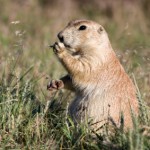Family, Description and Size:
Prairie Dogs are a type of ground squirrel, belonging to the family of Sqiuridae. There are four species of prairie dogs in North America: Utah, Black-Tailed, White-Tailed and Mexican.
They have long bodies, covered in light brown fur which is almost sand colored. They have squirrel-like heads with small ears and four teeth that keep growing throughout their life. They can easily stand on their hind legs.
On average, a Prairie Dog has a body length of 12 to 16 inches long and weighs around 1 to 3 lbs. There exists sexual dimorphism in the species, which means that males are usually larger than females, these differences though vary between all four species. Females are at their thinnest when weaning, while during that time the males are fattening up and are at their largest.
Range and Habits:
Prairie dogs, like their name suggests, prefer open-spaced territories. Their range is from 2000 to 10000 feet above sea level. Their burrows protect them from high and low temperatures.
Prairie dogs are herbivores, though they eat some insects when they have the chance. Some of the many plants they eat are grass, tumble grass, buffalo grass and others. They also like to feed on crops when they can and love the same grasslands usually used for rearing cows and horses.
General Information:
Prairie dogs are very social animals. They live in large colonies and dig common burrows. These burrows can be 16-33 feet long and 6 to 10 feet deep. The entrances are 4 to 12 inches wide in diameter. Some mounds, or dome craters as they are also known, can be 8 to 12 inches high, but rim craters can actually reach a height of 3 feet. The burrows have chambers in them, each dug for a different function. Some are nurseries, some are listening posts, a few are night chambers and winter chambers and they even have air chambers to protect them from floods.
The Black-Tailed and Mexican Prairie Dogs display a unique behavior called “jump-jip”. They will jump in the air, while standing on their hind legs, reach up with their front paws in a “praying” position and let out a loud “jip” while doing so. This behavior is both intriguing for scientists, which have yet to find a reason behind it, and very entertaining for anyone who sees it.
Prairie dogs also have a distinct mating call which they will use when the female is in estrus. She will then copulate with the male, usually in the burrows as not to be interrupted by other males or hunted by predators. Mothers do most of the rearing of the young, by protecting the nursery, feeding the young and brining fresh grass. Males will do their part by protecting the territory and maintaining the burrow.
Infanticide is known to take place in Prairie Dog societies when a new male takes over a burrow. He will then proceed to kill all young fathered by the previous male leader so that he can father his own sooner.
The burrows of the Prairie Dogs are a great concern of farmers and ranchers. The Prairie Dogs can both ruin crops and compete with cows for food. Their large burrows can sometimes cause severe damage to free-range cattle, such as broken limbs and slow, painful death afterwards.
Even though they can carry the plague and other diseases, Prairie Dogs have gained popularity as pets and zoo animals, because of their social behavior and appearance. Like many pet owners, people who adopt Prairie Dogs seem to enjoy them while they are small, but soon release them into urban environments when they grow larger and harder to handle. If you ever get a chance to drive through Amarillo, Texas, you can see them within city limits, in parks, on front lawns and even in areas you would never expect to see them.
Predators, Mortality and Lifespan:
There are many predators the Prairie Dogs must watch out for, like the Coyote, Black Footed Ferret, the Kit Fox, the American Badger, the Ferruginous Hawk and the Golden Eagle. Nonetheless, the plague, habitat destruction and humans are their greatest concern.
Prairie Dogs can also carry the bubonic plague and die from famine and diseases like most other species. The plague can be so serious, oftentimes entire colonies can be wiped out. Their average life-span is 8 and a half years, but some individuals have been reported to reach the age of 12.



